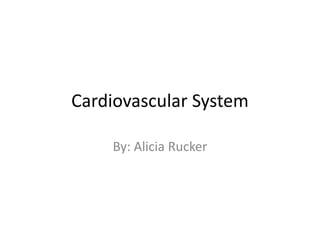Cardiovascular system
- 1. Cardiovascular SystemBy: Alicia Rucker
- 2. Cardiac ScanCardiac CT, is a painless test that uses an x-ray machine to take clear, detailed pictures of the heart. This common test is used to look for problems in the heart.During a cardiac CT scan, an x-ray machine will move around your body in a circle. The machine will take a picture of each part of your heart. A computer will put the pictures together to make a three-dimensional (3D) picture of the whole heart.
- 3. Cardiac Scan Cont.Sometimes an iodine-based dye (contrast dye) is injected into one of your veins during the scan. The contrast dye travels through your blood vessels, which helps highlight them on the x-ray pictures. Because an x-ray machine is used, cardiac CT involves radiation. Although the amount of radiation used is considered small, it's similar to the amount of radiation you're naturally exposed to over a 3-year period.
- 4. Cardiac Scan Cont.There's a small chance that cardiac CT will cause cancer because of the radiation involved. The risk is higher for people younger than 40 years old, especially children. However, new cardiac CT methods are available that reduce the amount of radiation used for this test.
- 5. Cardiac Scan Cont.Cardiac CT is a common test for finding and/or evaluating: Calcium buildup in the walls of the coronary arteries, problems with heart function and heart valves, problems with the aorta, blood clots in the lungs, problems in the pulmonary veins and pericardial disease.
- 6. VenographyA procedure in which an x-ray of the veins is taken after a special dye is injected into the bone marrow or veins. May be used to identify a thrombus.
- 7. Cardiac CatheterizationThe insertion of a catheter into a chamber or vessel of the heart. These are done to detect abnormalities, to collect cardiac blood samples, and to determine the blood pressure within the heart.






